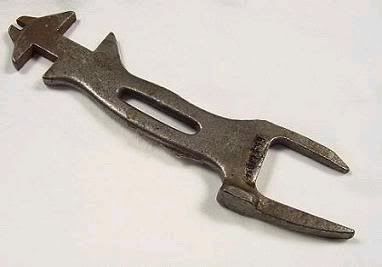|
|
Post by Rod on Jun 24, 2011 16:07:19 GMT -7
An acquaintance and I were emailing back and forth, and were wondering what sort of tool was used to dismount the nuts on the bottom of beaver traps, if one had to replace the springs? I've never read of any wrench being carried, does anyone have any ideas on this?
Coincidentally, I bought an early beaver trap recently. As it was missing one of the springs, and the other spring didn't fit it too well (period replacement), and was without chain, I picked it up rather cheaply. I took it out to Ft. Union last weekend, and replaced both springs and gave it a new chain. Reminded me of Johnson Gardiner buying traps and springs from the same place in the 1830s.
Anyway, that reminded me of the email exchange. Replacing springs would be easy enough at a fort, with decent blacksmith tools, but what about out in the field? Wouldn't take long in water for those nuts to rust tight.
Rod
|
|
|
|
Post by beaudro on Jun 29, 2011 9:05:01 GMT -7
hello Rod.
Would that acquaintance be me? I found a picture online awhile back of what is suppose to be a Newhouse trap tool , I don't recall seeing markings on the tool and if it's the real deal it might still only be similar to something pre 1840. It was a multi-tool if I remember correctly.
As you mention blacksmith tools, i think this tool was kept and used by a smith for sure. There may have been several in different sizes or a multi-wrench that fit a few sizes. I was thinking I read some parties carried extra springs, so there is a little evidence of a field repair possibly.
To replace a spring, in the field, is a question I think on a lot. As I've made several traps now and I have learned things are being much more complicated. One spring won't fit just different traps. One side of the "V" spring is longer, it accommodates the travel from the post up to the top of the jaw, but when compressed the eye has to fit down over the jaw post well enough to be able to set the trap. On modern traps it doesn't matter , you can turn the springs over on most I know of and they are the same length on both sides as well. On originals the math is more complicated, but if several traps are the same then the springs can be changed out with a spare with no major adjustments. Of course when your in a pinch you take out your file and make do with what you got.
After a short time I'm sure the threads on the post are gonna be gone, wrought iron wouldn't hold up to much work anyway. A smith probably made a new post and replace the nuts, and jaw pins. So would a trapper even be in need of a tool?
I think the tool exists, possibly someone in the party kept up with it, a smith had several maybe, a smith could make one on the fly, it came with an order of traps, but most likely what we are going to find is in the smiths toolbox.
|
|
|
|
Post by Rod on Jun 29, 2011 12:17:34 GMT -7
Yep, that would be you ;D
You're probably right in that we won't find the individual tool listed, it was probably with a set of tools that a brigade might carry. Those guys could do some rather sophisticated repairs in the field---Osborne Russell's mention of repairing a gun tube, and Wyeth's conversion of a couple of flinters to percussion comes to mind. A smaller group or an individual might have a tougher time, as they might not be carrying such an extensive tool kit?
If I recall correctly, Johnson Gardiner bought something on the order of 16 traps and 8 trap springs while at Ft. Union (don't have my copy of Chittenden handy)---I'd have to assume that breakage was a problem with springs at that time.
Rod
|
|
|
|
Post by beaudro on Jun 29, 2011 12:46:21 GMT -7
I'm fortunate to have the acquaintance Rod, I went back and found the picture of the said Newhouse trap tool, It belongs to a reputable trap collector. To me it looks like a buggy wrench, but the Newhouse collectors were talking about the difference between a buggy wrench and this trap wrench. It remains to be seen , I suppose the idea of a trap wrench could have developed from the same idea as a buggy wrench.  |
|